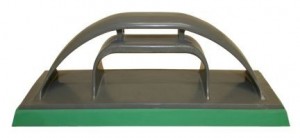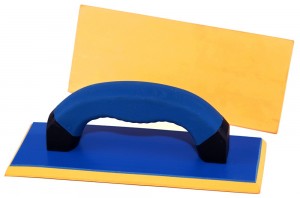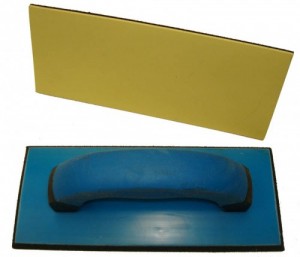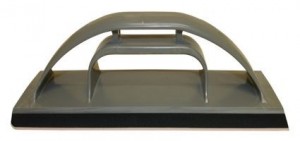Each type of grout has a specific consistency, and it is important to choose the appropriate float or it will be difficult to manipulate the grout. Harder grout floats will scratch softer materials. You should choose the least abrasive grouts when working with softer stones and tiles, and use a float with a more flexible face. Regarding scratching surfaces, I suggest avoiding metal back floats. They have been around for a long time, but their reputation for scratching and marking tile and stone is well deserved.
Epoxy Grout Floats - Barwalt UFF-1 and Master Wholesale (MWI) Premium Epoxy Float
Epoxy grout has a thick, and sticky consistency. It sets up fairly quickly, and is rather difficult to clean up. You need a hard rubber float when spreading epoxy grout. The rubber must also resist the epoxy or else it will gum up on the float. The MWI Yellow Epoxy Float works great. The hard rubber doesn’t stick to the epoxy, and the smaller size (4” x 9”) makes it much easier to control and push the thick epoxy into the joint. The Barwalt UFF-1 float is another good epoxy float, but personally I don’t find that it fits my hand as well as the MWI float. We carry others but these are my two favorites.
Traditional Grout Floats - MWI Premium 4" x 9" float and Barwalt UWF-2
For urethane grout, I prefer the same two floats as above, assuming the material is hard and does not scratch easily. Urethane grout contains silica and recycled glass that can scratch softer tiles and stone. With softer stone or any tile you suspect might scratch, it is always best to test on a corner or scrap piece first.
The Barwalt UWF-2 and MWI Premium 4" x 9" floats are my personal favorites for conventional sanded and unsanded grout. Both have the appropriate rubber compound that allows you to easily get the ground into the joint without leaving haze or waste behind. Both of these floats will last for multiple jobs. Honestly, between them, it really comes down to which handle you prefer.
If you do a significant amount of grouting, you’ll want to pick up a margin trowel style grout float and maybe a toe-kick float. These make easy work of the hard to reach areas and you’ll be glad you have them in your grouting arsenal.




